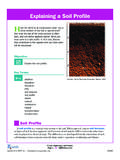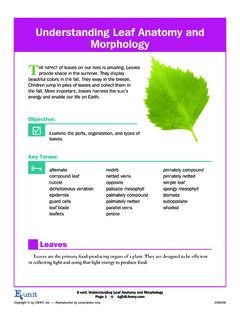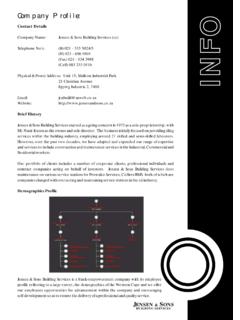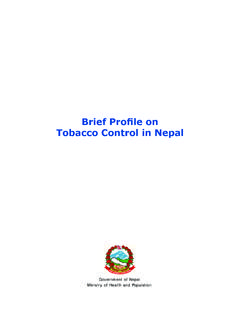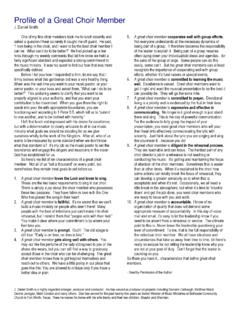Transcription of Explaining a Soil Profile - Seneca High School
1 Explaining a soil ProfileHAVE YOU NOTICEDat construction sites how across section of soil has a layered look? soil near the top of the cross section is oftendark, and soil below appears lighter. What youhave seen is a soil Profile . In this unit, factorsthat contribute to the layered look you have seenwill be : Explain the soil Terms: additioneluviationilluviationlosssoil horizonssoil profilesolumsubsoilsubstratumtopsoiltran sformationtranslocationSoil ProfileAsoil profileis a vertical cross section of the soil . When exposed, varioussoil horizons,or layers of soil , become apparent. Each horizon of soil may be different from the other hori-zons in physical or chemical ways. The differences are developed from the interaction of suchsoil-forming factors as parent material, slope, native vegetation, weathering, and : Explaining a soil ProfilePage by CAERT, Inc. Reproduction by subscription (Courtesy, Natural Resources Conservation Service, USDA)A soil Profile is usually studied to a depthof 3 to 5 feet.
2 To see the soil Profile , soil coresmay be taken or holes dug to expose the pro-file. A soil core or auger allows the extractionof a cylinder of soil for TO THE SOILPROFILEAs a soil ages, horizontal layers develop andchanges result. The causes of these changesare classified as four processes. Each processoccurs differently at various depths in the This process occurs as mate-rials such as fallen leaves, windblowndust, or chemicals from air pollution areadded to the This process occurs when mate-rials are lost from the soil because ofdeep leaching or erosion from the This process involvesthe movement of materials within thesoil. It can occur with deeper leachinginto the soil or with upward movementcaused by evaporating In this process, materials are altered in the soil . Examples areorganic-matter decay, weathering of minerals to smaller particles, and chemical HORIZONST here are three primary soil horizons, called master horizons.
3 They areA, B, part of a system for naming soil horizons in which each layer is identified by a code:O, A,E, B, C, is an organic layer made up of partially decayed plant and animal debris. Itgenerally occurs in undisturbed soil , such as in a is often referred to as thetopsoiland is the surface layer where organicmatter accumulates. Over time, this layer loses clay, iron, and other materials because of leach-ing. The movement of organic matter, chemical substances, and mineral particles from theupper horizons of soil to the lower horizons by the downward movement of water is calledE-unit: Explaining a soil ProfilePage by CAERT, Inc. Reproduction by subscription 1. soil Profile . (Courtesy, Natural ResourcesConservation Service, USDA)eluviation. TheAhorizon provides the best environment for the growth of plant roots,microorganisms, and other is the zone of greatest eluviation. Because the clay, chemicals, and organicmatter are leached, the color of theEhorizon is very light.
4 This horizon usually occurs insandy forest soils with high amounts of is often referred to as thesubsoil. It is often called the zone of accumula-tion because chemicals leached from theAandEhorizons accumulate here. The accumula-tion of organic matter, chemical substances, and mineral particles in the lower horizons of soilfrom the upper horizons as a result of the downward movement of water is has less organic matter and more clay than the A horizon. Together, theA, E,andBhorizons are known as thesolum. This is where most of the plant roots is called thesubstratum. It lacks the properties of theAandBhorizonsbecause it is influenced less by the soil -forming processes. It is usually the parent material ofthe is the underlying bedrock, such as limestone, sandstone, or granite. It isfound beneath : Explaining a soil ProfilePage by CAERT, Inc. Reproduction by subscription THE CONNECTION: soil ScientistSoil scientists study the chemical, physical, biological, and mineral characteristics of study of the soil is frequently associated with plant growth.
5 The work of a soil scientistmight include the responses of various soil types to fertilizers, soil composition, and drainagepatterns. soil scientists are called upon to provide information and recommendations to nurseryowners and operators regarding thebest use of land, plant growth, andsoil erosion. Application of precisiontechnologies has grown in impor-tance for practicing soil soil scientist generally pursuesan associate s or baccalaureatedegree in soil science. Many soil sci-entists obtain further formal educa-tion through postgraduate career opportunitiesare available with government agen-cies conducting soil surveys andclassifying and mapping soils. Privateindustry also provides opportunitiesfor qualified WANTED(Courtesy, Natural Resources Conservation Service, USDA)E-unit: Explaining a soil ProfilePage by CAERT, Inc. Reproduction by subscription "30"48"Topsoil:humus, roots,organismsSubsoil:fine particles,leached materials,some rootsParent Material:weatheredbedrock andsome leachedmaterialsBedrock:underlyingsolid rockFIGURE 2.
6 Diagram of a soil :2A soil Profile is a vertical cross section of the soil . The differences are developedfrom the interaction of such soil -forming factors as parent material, slope, nativevegetation, weathering, and a soil ages, horizontal layers develop and changes result. The causes of thesechanges are classified as four processes: addition, loss, translocation, and are three primary soil horizons, called master horizons. They areA, B, are part of a system for naming soil horizons in which each layer is identifiedby a code:O, A, E, B, C, is often referred to as the topsoilTheBhorizon is often referred to as the subsoil. TheChorizon is called the Your Knowledge: 1. What is a soil Profile ?2. What factors are involved in the development of soil profiles?3. What are the four classes of changes to soil horizons?4. What are the master horizons?5. How do eluviation and illuviation differ?Expanding Your Knowledge:LParticipate in a soils career development event with your classmates.
7 Apply yourknowledge of soil profiles during the competition. An alternative is to dig a holeseveral feet deep into a soil that has not been disturbed. Study the Profile of the soiland identify the Links:: soil : Explaining a soil ProfilePage by CAERT, Inc. Reproduction by subscription
